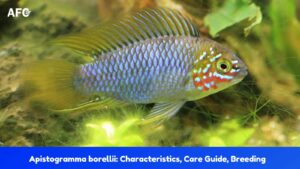Apistogramma is the largest genus of dwarf cichlids, with 93 recognized species distributed in tropical South America east of the Andes. However, over 400 undescribed species and various Apistogramma types have been reported in the hobby, according to a 2021 article entitled “A Description of Apistogramma Species-Groups” by Mike Wise.
Knowing the different kinds of Apistogramma species groups can help aquarists select the most suitable fish for their aquariums and identify the specific species they have.
Not all Apistogramma species are readily available in pet stores. In fact, most of them are indigenous to small watersheds or a single river and have never been imported. Specimens sold in shops are mostly captive-bred.
Wild-caught Apistos have muted colors to help them blend in and escape predators. From red to blue to yellow to orange, domestic strains come in an amazing array of vibrant colors that make them a showstopper in any community tank.
Here is a list of the 10 different Apistogramma species in the aquarium trade.
- Apistogramma cacatuoides
- Apistogramma agassizii
- Apistogramma macmasteri
- Apistogramma borellii
- Apistogramma trifasciata
- Apistogramma panduro
- Apistogramma viejita
- Apistogramma hongsloi
- Apistogramma baenschi
- Apistogramma elizabethae
1. Apistogramma cacatuoides
Apistogramma cacatuoides, also known as the “Cockatoo Dwarf Cichlid,” is the most recognized Apistogramma species in the aquarium hobby. As per its common name, the male closely resembles a cockatoo’s crest with its long and spiky dorsal fin.
In recent years, selective breeding has created several beautiful color mutations of A. cacatuoides, including “Super Red,” “Double Red,” “Triple Red,” and “Orange Flash.”
The adult males are larger, strictly polygamous fish that can be aggressive during breeding. They do best in a harem situation with 2-3 females per male.
Cockatoo dwarf cichlids are easy to breed in a home aquarium because they can thrive in slightly hard water, unlike other species that require very soft and acidic water for successful reproduction.

2. Apistogramma agassizii
Apistogramma agassizii, or the Agassizi’s Dwarf Cichlid, is the next most commonly kept member of the Apistogramma family and is widely available at pet shops everywhere.
Agassizi’s dwarf cichlids are distinguished by their long and laterally flattened bodies with a pronounced spade-shaped caudal fin (tail fin). They also come in an amazing selection of man-made morphs, with the most popular ones being “Fire Red,” “Double Red,” “Blue Flame,” and “Gold.”
Being a strictly polygamous Apistogramma species, the mature males will become extremely aggressive towards females who are not ready to breed in their territory. They must be kept in a minimum ratio of one male to at least two females in a properly decorated tank.

3. Apistogramma macmasteri
Apistogramma macmasteri is a colorful and hardy Apistogramma fish that can tolerate a wide range of water quality parameters, especially water hardness, making it a popular choice for community aquariums.
This species gets the nickname “red shoulder dwarf cichlid” and “red neck apisto” from the red or golden patches on its operculum (gill cover). Males have moderately high dorsal fins with hard serrated spines.
A. macmasteri is relatively easy to breed. The males are opportunistic monogamous breeders, which means they are less aggressive than polygamous species and usually form a pair.
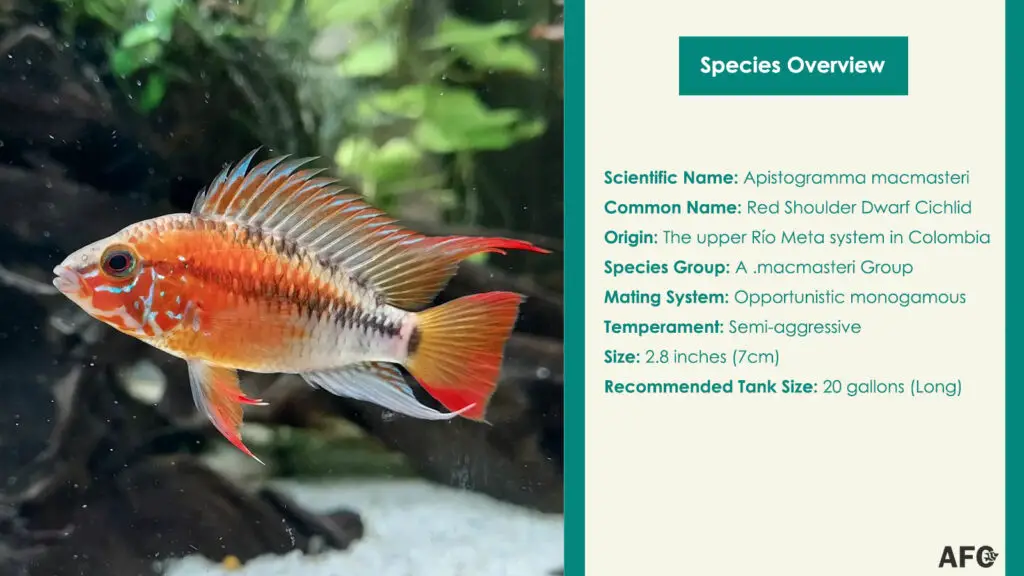
4. Apistogramma borellii
Apistogramma borellii, often referred to as yellow dwarf cichlid, is considered the #1 beginner Apistogramma fish due to its smaller size, peaceful nature, and undemanding water conditions. It can handle a wide variety of temperature fluctuations compared to that of A. macmasteri.
Two naturally occurring types of A. borellii are popular among cichlid enthusiasts: “Blue” and “Opal.” “Blue” varieties have a head that is almost entirely yellow, while “Opal” types typically exhibit coloration with a mix of red, blue, and yellow pigments.
Similarly, A. borellii are opportunistically monogamous species, with males will be happy to form bonds with females. However, these bonds are not permanent or lifelong and can be broken if opportunities arise. A single pair can be comfortably housed in a 10-gallon tank.

5. Apistogramma trifasciata
Apistogramma trifasciata is the most widely distributed Apistogramma species, which extends into subtropical regions of South America. As a result, there are more than twenty geographic populations of this species, which is easily found for sale and can tolerate a broad spectrum of water quality parameters.
A. trifasciata is characterized by three distinct horizontal dark stripes on its streamlined body. The males develop long extensions on the tips of the dorsal and caudal fins. Its striking streaks of gold and blue make this fish a colorful addition to any community freshwater aquarium.
Like some other strictly polygamous Apistogramma species, males of A. trifasciata are highly aggressive towards females that are not willing to breed in their territory. Therefore, they usually are kept in a good grouping consisting of one male and several females, in a minimum tank size of 20 gallons (Long).
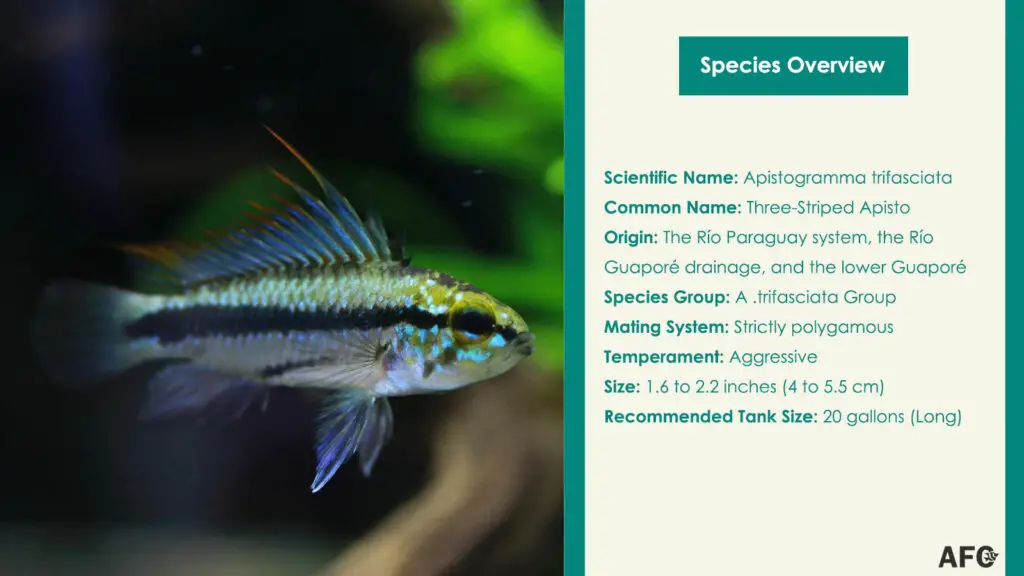
6. Apistogramma panduro
Apistogramma panduro is a medium-sized Apistogramma species native to the black-water streams of the Río Tahuayo and Río Tamshiyacu drainages in Peru, which are known for having temperatures of 75–79°F (24–26°C) and low pHs between 4.8 and 5.9.
Growing up to 2.8 inches (7 cm), males have strong jaws, large lips, and relatively deep bodies with contrasting triangular spots that cover the entire caudal peduncle and extend into the middle section of the caudal fin.
Like other species of the A. nijsseni species group, Apistogramma panduro is strictly polygamous, which requires a ratio of at least one male to at least two females in a larger tank with ample room to establish their territories.

7. Apistogramma viejita
Though Apistogramma viejita is distributed over a narrow range in the wild, captivity-bred strains have become very popular in the aquarium hobby, given their bright coloration and resilient ability to live in a wide range of water conditions.
Many confuse A. viejita with A. macmasteri due to their similar prolonged anterior dorsal fin lappets. However, A. viejita is slightly smaller and more slender in males. The primary difference lies in the darker red edge of the dorsal fins in Apistogramma viejita.
A. viejita are opportunistically monogamous; males are less aggressive in temperament. Because of their relatively peaceful nature, they can get along with other small or similar-sized tropical community fish, like cory catfish, tetras, and rasboras.

8. Apistogramma hongsloi
Apistogramma hongsloi originates from the middle of the Orinoco River and has half a dozen geographic populations. Although wild-caught specimens may be seen for sale online, their selectively bred counterparts are commonly found in several color morphs.
Hongslo’s dwarf cichlid differs from other Apistogramma species with its stout body, strongly serrated dorsal fin, distinctive horizontal stripe, and dark caudal fin marking.
A. hongsloi can be kept in moderately hard water with a neutral pH of 7 and a water temperature of 79°F (26°C). However, as with most Apistogramma species, soft and acidic water enhances its vibrant coloration and encourages productivity.

9. Apistogramma baenschi
Apistogramma baenschi is a fairly new addition to the Apistogramma hobby. It was first introduced in the U.S. and Japan in 2002 but quickly gained popularity among many hobbyists due to its hardiness, attractive coloration, and interesting behavior.
A. baenschi is distinguished by five vertical dark bars on its sides, a small and rounded caudal fin edged with red, extended dorsal fin lappets, and a distinct anal spot.
Similar to A. panduro, A. baenschi belongs to the A. nijsseni species group, where most members are strictly polygamous. The males get feisty towards each other, or the females are not willing to breed in their territory. Therefore, a larger tank with plenty of hiding places and cave-like structures will be necessary.
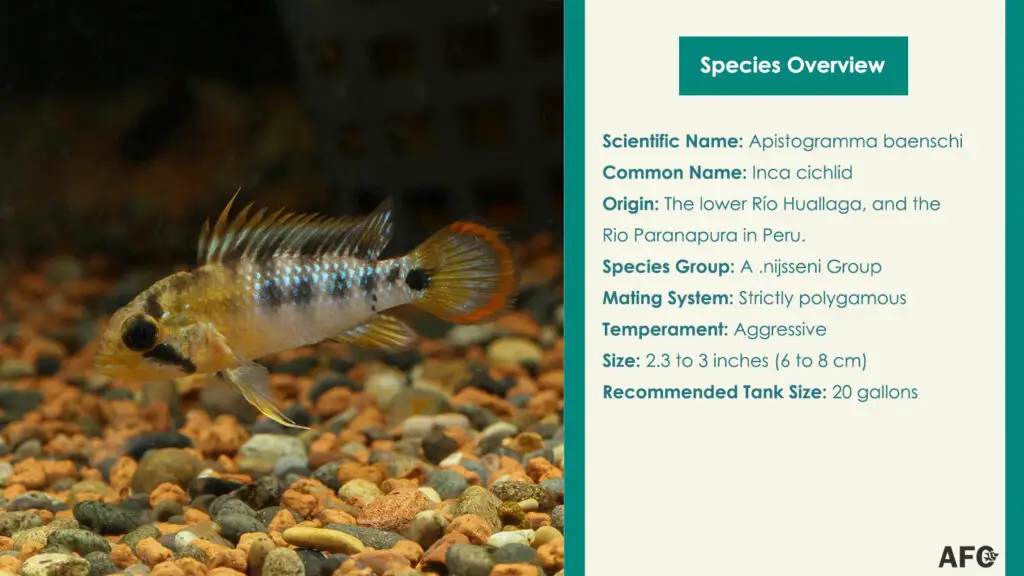
10. Apistogramma elizabethae
Apistogramma elizabethae, also known as the Elizabeth’s Dwarf Cichlid, is a small, colorful fish that is native to the blackwater rivers of South America. They are known for their delicate beauty and their challenging breeding requirements.
Mature males of A. elizabethae boast an elongated and elaborate dorsal fin, accompanied by an attractive body coloration of vivid red and blue hues. The development of the caudal fin can be used to identify this fish.
A. elizabethae can acclimatize to a home aquarium environment with a broad range of temperatures, pH, and water hardness. However, creating a setup that mimics its natural habitat is crucial for maintaining optimal health and promoting successful reproduction.
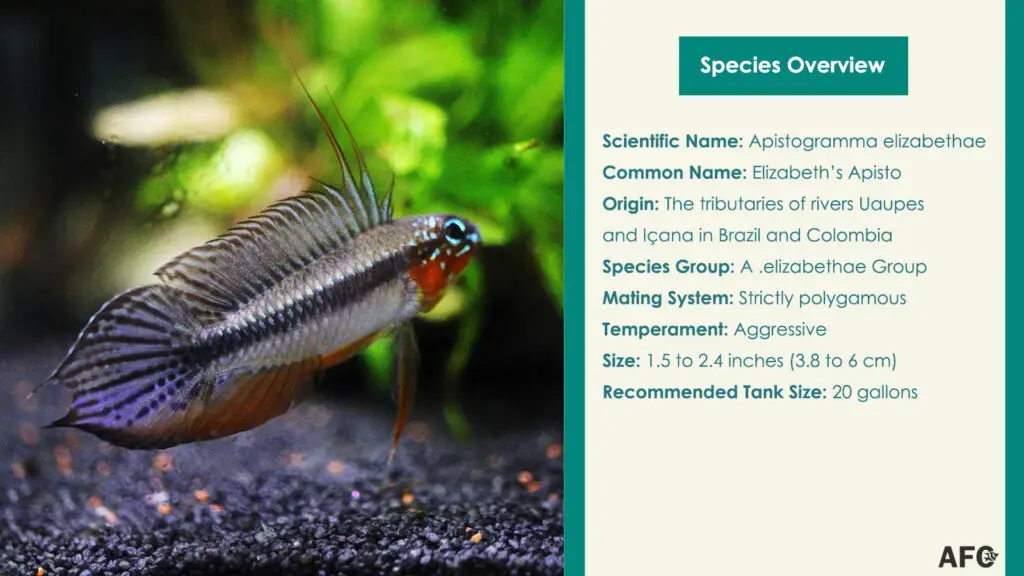
What Are the Different Colors of Apistos?
The four primary colors of Apistogramma are red, blue, yellow (gold), and orange.
The color of Apistogramma is impacted by a wide variety of different elements, but two of the most important are their genetics and dietary sources.
Genetics determine how much of a specific type of pigment-containing cells called chromatophores the Apistogramma fish can produce.
The main types of chromatophores found in ornamental fishes influence coloration as follows: erythrophores (red), cyanophores (blue), xanthophores (yellow to ocher), leucophores (white), and melanophores (black).
Bright colors like red, blue, yellow, orange, and green are generally produced from carotenoids that come from fish’s diet, while dark or grayish colors are usually produced by melanin.
Since the color of fish can be passed down through generations via inheritance, breeders are able to selectively choose and cultivate specific color variations of Apistogramma, and we’ll likely see more aesthetically pleasing colors.

What Are the Most Popular Red Apistogramma Varieties?
The most popular red Apistos are the following.
- Apistogramma cf. agassizii ‘Double Red’
- Apistogramma agassizii ‘Fire Red’
- Apistogramma cacatuoides ‘Triple Red’
- Apistogramma cacatuoides ‘Super Red’
Red Apistogramma fish are the most common because the gene that produces erythrophores is dominant. Additionally, red pigments can easily be obtained through the food they eat.
What Are the Most Popular Blue Apistogramma?
The most popular blue Apistos include the following species and color forms.
- Apistogramma sp. ‘Steel Blue’
- Apistogramma agassizi ‘Neon Blue’
- Apistogramma panduro
- Apistogramma borellii ‘Blue’
Blue is an uncommon color in Apistogramma fish. Although cyanophores contain bluish pigments, the brilliant blues are actually caused by interference effects, or structural coloration, rather than by pigments.
For those who want to see their blue Apistos sporting their most colorful hues, consider providing them with melanin-rich foods.
What Are the Most Popular Yellow/Gold Apistogramma Varieties?
These are some of the most popular yellow or gold Apistogras in the hobby.
- Apistogramma allpahuayo ‘Yellow’
- Apistogramma cf. agassizii ‘Golden’
- Apistogramma viejita ‘Gold’
- Apistogramma borellii ‘Opals’
Similarly, yellow Apistos are usually dominated by the xanthophore gene, although carotenoids from food can also enhance their yellow colors.
What is the Most Popular Orange Apistogramma?
The most popular orange Apisto is the A. cacatuoides ‘Orange Flash.’ It is known for its bright yellow body with a striking orange dorsal fin and tail.
Orange in fish is a combination of red and yellow chromatophores, resulting in a unique coloration not often seen in wild populations.
What Are the Rare Apistogramma Species?
These are some of the rare wild-caught Apistogramma species found in the United States.
- Apistogramma mendezi
- Apistogramma kullanderi
- Apistogramma flavipedunculata
- Apistogramma piaroa
- Apistogramma personata
- Apistogramma psammophila
- Apistogramma erythrura
- Apistogramma sp. ‘Alto Tapiche’
- Apistogramma sp. ‘Abacaxis’
How Many Apistogramma Species Are There?
There are 93 described species of the Apistogramma genus, which are divided into many taxonomic groups based on morphological characteristics and genetic analysis.
For years, ichthyologists and Apistogramma enthusiasts have placed the majority of Apistogramma species into 3 distinct lineages, according to a study published in the International Journal of Molecular Sciences. Mike Wise, an Apistogramma expert, has further identified and grouped these species into 24 species complexes, 16 species or species groups, and two sublineages in four lineages.
How to Identify Apistogramma Species?
To identify Apistogramma species, consider the following factors and characteristics.
- Purchase source: Many Apistogramma species are available in fish stores and online. Ask the dealer whether the specimen is wild-caught or tank-bred. For wild-caught individuals, check for their collecting locality and its corresponding name.
- Size: Apistogramma species vary in size, with certain complexes tending to be larger. These complexes include kullanderi, regani, alacrina, steindachneri, and cacatuoides. Identifying the exact species of juvenile fish can be challenging.
- Body shape: Ancestral Apistogramma species, such as those belonging to the regani Group, kullanderi Complex, alacrina Group, macmasteri Group, steindachneri Group, pertensis Complex, as well as A. arua and A. salpinction, have deep-bodied and laterally compressed shapes. Conversely, evolved Apistogramma species typically have more slender bodies that are slightly flatter.
- Dorsal fin size and shape in males: The males of evolved Apistogramma species possess large, serrated dorsal fins with elongated anterior spines and lappets.
- Lateral line: Apistogramma species exhibit a dark stripe along the lateral line. The width of this lateral line can vary, and it may break up into spots or display a zigzag pattern. In some species, the lateral line may be entirely absent.
- Caudal fin spot: Most Apistos have a black spot at the base of the tail. The size and shape of this spot can differ among species, and in certain cases, it is connected to the lateral band that extends into the caudal fin.
- Tail Fin Shape and Markings: Apistogramma cichlids come in different tail types, from round to lyre-shaped. Their caudal fins are often adorned with spots, bars, or stripes in contrasting colors. Many species feature extensions in the top and bottom portions of the tail fin.





